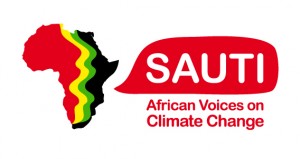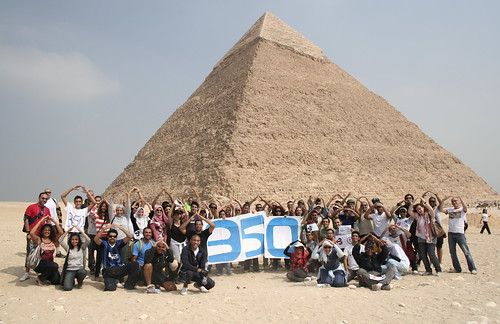 We are excited to announce the beginning of a series of dispatches from climate movement leaders from across Africa. We are calling the series “Sauti — African Voices on Climate Change.” Sauti means ‘voices’ in Swahili and ‘my voice’ in Arabic. It is an attempt to tell stories that go beyond tales of suffering from African, and instead celebrate those who are working to create solutions — facing great challenges with courage, commitment, and creativity.
We are excited to announce the beginning of a series of dispatches from climate movement leaders from across Africa. We are calling the series “Sauti — African Voices on Climate Change.” Sauti means ‘voices’ in Swahili and ‘my voice’ in Arabic. It is an attempt to tell stories that go beyond tales of suffering from African, and instead celebrate those who are working to create solutions — facing great challenges with courage, commitment, and creativity.
We begin Sauti with an introduction to our friend and a leading climate movement organizer in Cairo, Egypt, Sarah Rifaat:
How I became a climate activist
“What do you do?”
“I’m a graphic designer.”
“Then how come you’re doing this environmental stuff?”
 This exchange took place between an officer of the infamous Egyptian State Security service and myself, on November 24th, 2010. I got questioned before I was granted permission to organize an aerial art installation in the desert of Wadi El Natroun, outside Cairo for the 350 eARTh project – the global climate art project large enough to be seen from space.
This exchange took place between an officer of the infamous Egyptian State Security service and myself, on November 24th, 2010. I got questioned before I was granted permission to organize an aerial art installation in the desert of Wadi El Natroun, outside Cairo for the 350 eARTh project – the global climate art project large enough to be seen from space.
I avoided giving an elaborate response to that officer and just settled with “I like volunteering,” but if the situation was less tense I would’ve responded with: “In May 2009, I received an email that would later change my life and turn me into a climate activist working with 350.org. Before that email I had never heard of “climate activism” or of the 350.org movement for that matter.”
At the time I received that email, I had already graduated from university 2 years earlier with a degree in Mass Communication and had been working as a graphic designer at a local design agency. I volunteered to facilitate workshops for children at the World Environment Day celebration held in Cairo every year, and tried to lead a more environmentally conscious existence, but an activist I was not, climate or otherwise.
That email contained an invitation to a 3-week climate advocacy workshop in Turkey organized by 350.org, IndyACT and other partners. It presented an opportunity to join 20 other young Arabs on a sponsored trip to Turkey to learn about climate change and to be given the tools necessary to organize in our communities for the first global day of climate action. When I first got that email I was feeling like something was missing in my life, a sense of purpose maybe. This workshop represented an opportunity to finally do something different and meaningful but it also meant that I had to leave my comfort zone – at the time I had never been away from my family or friends for more than a week.
After careful consideration, I decided to take time off from work and go to this workshop, not knowing if I would get along with the 200 other participants who hailed from 30+ countries, or what exactly I would doing after the workshop ended.
But, by the end of 3 weeks I had bonded with so many people from different countries and had the chance to share my ideas in new and liberating ways. More importantly, I realized how connected the climate issue was to everything and everyone on this planet. From devastating floods to human rights to social justice issues, we found the common thread between all of these — climate change. I learned that 350 ppm – the safe limit for carbon dioxide in our atmosphere – was the target humanity needed to reach (current concentration is 392 ppm and rising) if we were to protect our fragile human structures from extreme weather and radical changes to our planet’s climate system.
What also struck me was the realization that we as citizens have been largely marginalized from the global political discourse around climate change. 350.org and the growing global climate movement showed me that by using the power of grassroots organizing and global action, normal people and marginalized communities everywhere, who are affected by climate change the most, would be able to take a stand on climate change and reach out to global leaders and politicians on an unprecedented scale. So, in short, this workshop was a life-changing experience for me.
I came back full of conviction that an individual can make a difference, and that in fact you only need a small group of committed individuals to spur on real change.
I learned from the workshop that activism wasn’t necessarily what we in Egypt had been led to believe. We lived in a closely guarded police state, so the usual forms of activism (i.e. protests) inherently involved the risk of getting arrested or being beaten up by thugs, or portrayed in national media as criminals. So, the idea that we would get non-activists to actually go down in the street and do some sort of action for the climate was a big challenge. However, we weren’t planning on doing what was normally seen as activism in the Egyptian context. After all, I had learned at the workshop that creative and fun actions were the key to engaging the wider public. So that’s why my friends and I decided to have a bicycle rally to the pyramids.
Since 2008, there’s been a growing bicycling movement in Cairo and that was largely thanks to the Cairo Cycler’s Club, who were the first to spur on this movement by using Facebook to organize weekly Friday morning rides through the city. As a avid cyclist – but only outside Cairo on summer vacations – I had been aware of this initiative and I was dying to join them on their weekly rides but never actually got around to do it. After coming back from Turkey though, the immediate course of action was to contact them and ask them to collaborate with us on the first 350 action in Egypt.
We really didn’t know if our action would work out or not, but we created an event on Facebook asking people to ride their bikes to the Pyramids and pose for a photo with the number 350. Since we knew we didn’t have time to get permits or anything, we didn’t even attempt to contact media beforehand for fear that too many people would show up and the authorities would be tipped off and shut us down as a result. What happened was that around 70 people showed up and cycled from Tahrir square to the pyramids.
This was amazing to me because many of these people were not self-proclaimed “activists,” and were not strictly environmentally active, but there they were doing an act of “activism” and defying social norms pertaining to bicycling at the same time. The photo we took that day was among thousands of photos sent to 350.org from 188 countries, but it was one of the most featured images in what came to be called by CNN, “the biggest day of political action in the planet’s” history.

2 years, 2 UN summits, 2 global days of action and 1 global climate art day later (more on that to come), and I am more involved in the climate movement than ever. Of course, the Egyptian revolution has had an undeniable influence on activism in general, and on climate activism in particular. Moving Planet, this year’s global day of action, was largely inspired by the Egyptian revolution. Also, it was the biggest 350 global day of climate action to date to take place in Egypt. We marched and cycled in the hundreds in Cairo for better transportation infrastructure and even had a stage set up in a public garden – something which I didn’t imagine possible before the revolution.
So, to end an extremely long blog post, it is clear that a lot is happening to our world, whether it be social, political or physical transformation, and it is up to us as individuals to make sure it is for the better.
And that is why, Mr. State Security Officer, I am a climate activist.
For more info on Sauti, visit here.
